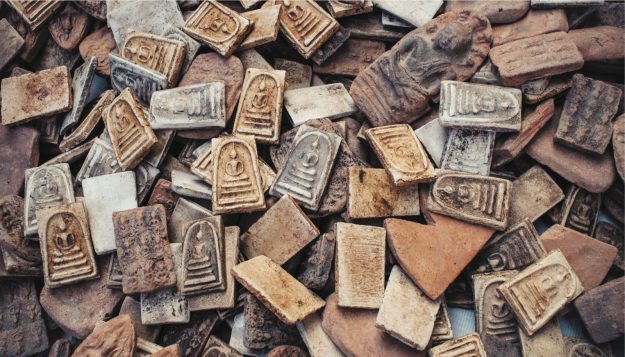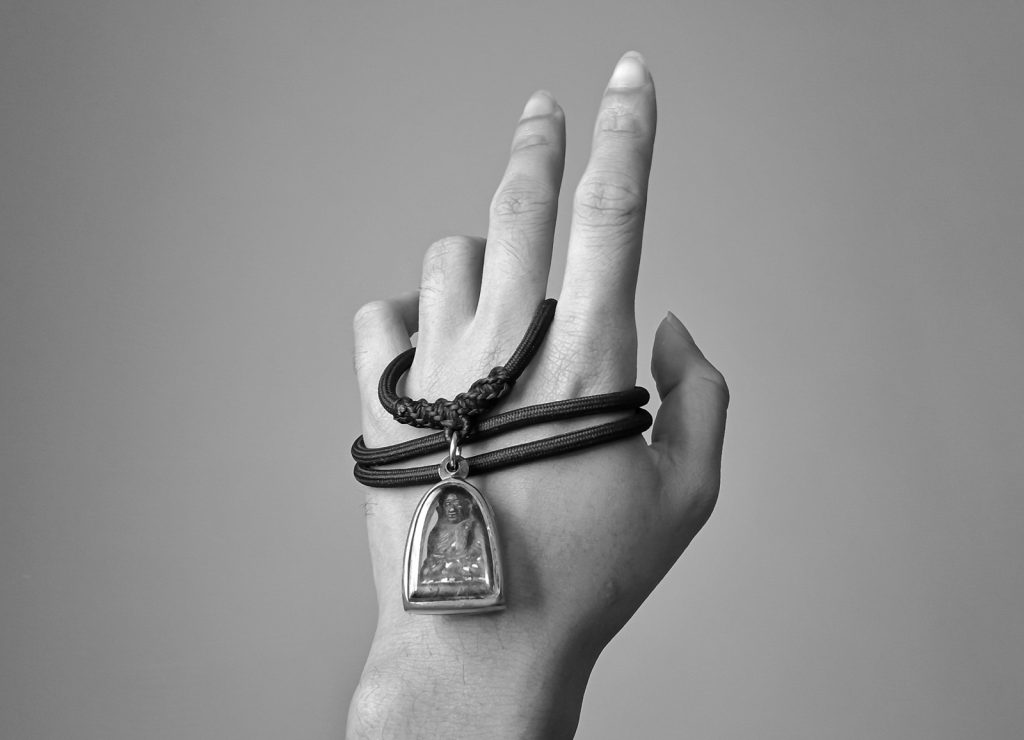Years ago, after living in Thailand for two years, I ordained as a monk at a small monastery near the Laos-Thailand border. The abbot once asked me, “Do you have a crucifix?” When I asked why, he said, “Because I want to add it to my arsenal.” He explained that if thousands of white people used them, they must be powerful, and he wanted to add one to his collection of Buddhist amulets. Years later, after returning to the States, I visited him again in Thailand and brought him a crucifix. He thanked me and put it with his amulets.
Thai Buddhist amulets (found to a lesser degree in Laos, Cambodia, and Burma) are powerful talismans designed to protect the possessor from harm and bad fortune or to attract love, money, and luck. Some amulets are passed down from parent to child or teacher to student, and some are traded on the open market. Amulets are part of an “economy of merit,” a karmic system in which acts of kindness, charity, and empathy are rewarded with future benefits. You reap what you sow. They are used for protection and for ensuring a successful outcome when you feel that your merit account is low.
Numerous stories attest to their efficacy, and people treasure them as valuable collectibles. Amulets have inspired magazines and websites that are full of stories about the value, beauty, and various miracles associated with them. Such stories are similar to the miraculous stories of healing and good fortune often told by devout Catholics after visiting a saint’s shrine or seeing an apparition of the Virgin Mary. They are a rich and complex source of historical and cultural information.
Amulets are called phra khrueang (“powerful tool”) or phra phim (“powerful stamp”) in the Thai language. Made mostly of clay, oil, bits of copper, fruit, and flowers and often quite small, some amulets cost more than two million dollars. In his three-volume study Phra Somdet, Akadet Khrisanathilok emphasizes that quality amulets start with phong, or powder of sacred quality. Such powders come in different combinations like phong keson (lotus, jasmine, plumeria, and other flower pollen), phong wan (the roots of sweet-smelling plants), and phong takrai bai sema (lemongrass powder from the boundary stones of monasteries). These plant materials are used not only for their olfactory and visual appeal but also for their therapeutic properties. In addition to these three basic types of powder, there are different mixtures with varying amounts of each ingredient. The amulets can be held and kept close to the heart on a necklace or soaked in holy water, and the medicinal powder is thus absorbed by the skin or water.
Material objects have been integral to the spread of Buddhism from the beginning.
The other substances in amulets are more mundane than the phong: oyster- and clam shell-flakes, lime, banana flower, ground jackfruit seeds, small scraps of monks’ robes, and pieces of palm leaf manuscripts. Some of these ingredients are roasted before being added to the mixture, and incantations such as the Namo buddhaya (homage to the Buddha), Itipiso (a chant about the qualities of the Buddha), Jina-panjara (“armor of the Buddha”), Bahum (the Buddha’s victory blessing), and various parittas (protective passages from suttas) are chanted over each ingredient.
Material objects have been integral to the spread of Buddhism, beginning with the relics of the Buddha. One could argue that buildings, images, stupas, and amulets have inspired Buddhist practice and belief in Southeast Asia more than doctrine and suttas have. Pilgrimages to and prostrations before sacred objects, the circumambulation of stupas, and the cherishing of amulets certainly occupy the days of Buddhists more than the close study of Pali texts does.
In the late 19th century, the Thai royal family began categorizing and ranking amulets, which contributed to the growth of their popularity, and after World War II the amulet trade became an important part of Thai religious life. At that time, stories of heroic police officers being protected by amulets while battling bandits became popular reading material. These stories, coupled with a growing interest in the study of their material and ritual production, increased the popularity of amulets.

Since sacred objects in Thailand are not meant to be owned, one “rents” instead of “buys” an amulet, and the renting and trading of amulets has become a massive industry. Because the income from amulet trade is distributed across a broad swath of society, the direct profits from their rentals are usually quite insignificant. Amulets are often produced in batches at ceremonies and are rented or given as gifts. An amulet is considered a most gracious way of thanking another person for their friendship, and delivers some merit in the bargain. If a devotee was not able to go to the monastery or ritual themselves, they can still share in the merit transmitted through a sacred gift of an amulet produced by the monastery.
The consecrations of amulets are popular events often connected with annual monastic fairs or anniversaries. These events produce a considerable amount of local revenue, and in some rural areas the amulet trade is an important part of the local economy. Consecration events attract people from other provinces, students, and monks, as well as pilgrims and invited honorary guests, and these people need places to eat, sleep, and shop. The entire community profits—food vendors, carnival ride operators, astrologers, the renters of sound equipment, local shopkeepers, souvenir makers, candle and incense companies and vendors, florists, motel owners, charter-bus companies, dance troupes, and many other individuals and groups. Even when monasteries provide free amulets, most people make some kind of donation. The monasteries selling the amulets participate in a local economy that involves many people who have nothing to do with the monastery, including those who don’t believe in the power of amulets and those who don’t identify as Buddhist.
“I see these monks and their amulets as creating new types of communities.”
The amulet markets located near monasteries are profitable businesses but not centrally controlled like other industries. No particular group of monks produces amulets or hoards the raw materials or secrets of production. Amulets are produced by monks of different ranks in many different monasteries. Amulet sales do not require elaborate storefronts, access to foreign technology, heavy machinery, tech repair specialists, lawyers, insurance, or a highly trained staff with salaries and benefits. The uneducated and non-elite can participate and become experts in the industry. Most amulet dealers I have met are not wealthy. There are certainly a few wealthy individuals who own a number of stalls in the larger amulet markets and thereby derive particular benefit from the trade, but for the most part, this is one of the few industries in Thailand that is equally accessible to the lower and middle classes.
Amulets also have many abstract and unseen dimensions, and they can help create communities and texts. The thoughts and visualizations inspired by amulets can generate questions about the teachings or help individuals develop new beliefs. Conversations during the trading of amulets can stimulate new teachings. They can provide a way to show sympathy to someone or assuage their fears, and sometimes they are simply a way to break the ice. New amulet-collecting clubs and charitable foundations form all the time, and this socializing leads to the writing of new texts, the tracing of new histories, the recounting and reinterpreting of local biographies, and an increase in regional pride.
The American writer Willa Cather famously quipped that “religion and art spring from the same root and are close kin. Economics and art are strangers.” But in the industry of Thai amulets, art, religion, and economics come together in creative ways. I see these monks and their amulets as creating new types of communities—communities of pilgrims, amulet traders, spiritual tourists, and similar online communities. Scholars so often separate culture and religion: Culture is something that “happens” to religion, and what happens is almost always negative. But if we seriously consider Thai Buddhist material culture and the objects incorporated into their religious repertoires, we can learn a lot about the motivations and values behind the production, use, and trade of Thai amulets, which cannot be reduced to mere commercialism.
Thank you for subscribing to Tricycle! As a nonprofit, we depend on readers like you to keep Buddhist teachings and practices widely available.
